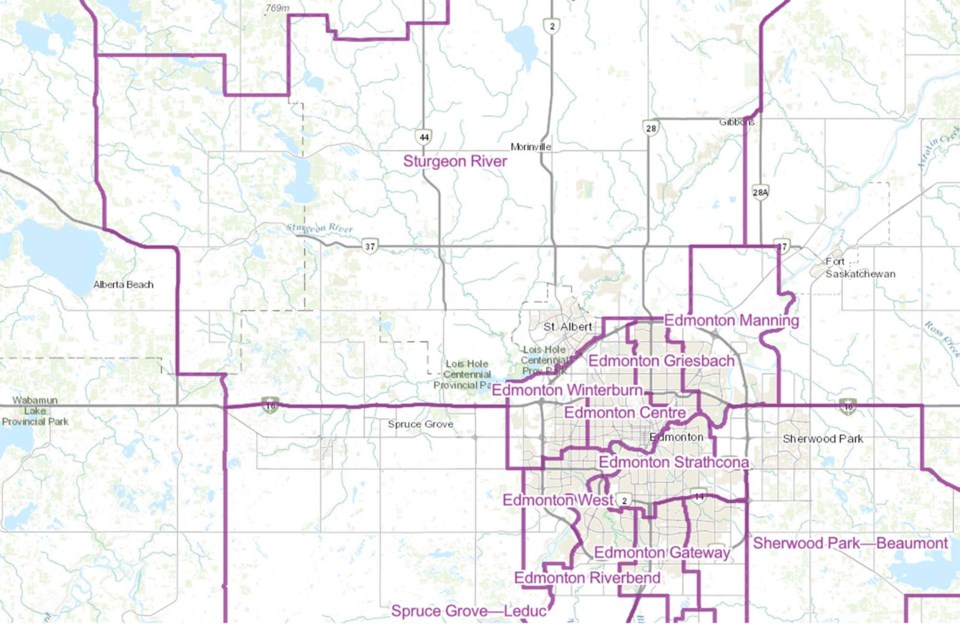Local MPs say the proposed new federal riding for St. Albert, which partners the city with rural communities like Morinville, rather than Edmonton, will honour the strong Francophone history in the area.
Earlier this month the Federal Electoral Boundaries Commission tabled its report on proposed changes to the province's federal electoral map in the House of Commons. After over a year of deliberation, the report outlines changes to the boundaries of the province’s federal electoral districts, including the partial amalgamation of the St. Albert—Edmonton riding with Sturgeon River—Parkland.
The new electoral map is set to separate the city of St. Albert from northwest Edmonton, grouping it with a large swath of Sturgeon County that includes Morinville, Legal, Calahoo, and Onoway to become the riding of Sturgeon River.
While the St. Albert-Edmonton riding has been in place for nearly two decades, the merger with Sturgeon County is much more a reversion than a first, said St. Albert MP Michael Cooper
“Looking at historical electoral boundaries, something the commission is statutorily required to consider, St. Albert had always been connected to Sturgeon County prior to the redistribution that took place before the 2004 election,” said Cooper.
Sturgeon River—Parkland MP Dane Lloyd said he thinks its positive St. Albert will be linked with the communities along the Highway 2 corridor north of the city
“Morinville, Legal, and Rivière Qui Barre all have a similar Francophone, Metis, and Indigenous heritage to St. Albert. Also, folks in Legal and Morinville drive through St. Albert every day, so it’s a natural economic and cultural corridor. And I also think it’s positive that Redwater and Gibbons, which were not originally in the riding, are now included. They’re a part of Sturgeon County, and I think it’s important to keep those communities together.”
More seats for Alberta
Informed by the results of the 2021 census, the 2022 redistribution will increase the influence of Alberta, a province that has historically had a disproportionately high electoral quotient, and thus disproportionately low representation in Ottawa.
“It’s a positive change in direction,” said Lloyd. “Alberta got three more seats, more than any other province. It reflects our growing population, which I believe will continue to grow.”
But the outcome of the redistricting process may also have implications on the nature of the local political landscape and the texture of life throughout the city’s new riding.
While it is currently part of an exclusively urban riding, St. Albert will be the only major city in the much more rural riding of Sturgeon River.
“The St. Albert — Edmonton riding has worked well over the past 20 years,” said Cooper.
“There are communities of interest between northwest Edmonton and St. Albert. I would have been fine if that riding remained intact, but it was evident in the proposal of the commission that they were moving away from hybrid ridings that include part of Edmonton and also surrounding communities.
Right now in Alberta, there are only two ridings that are considered hybrids: St. Albert — Edmonton and Edmonton — Wetaskawin, Cooper noted.
“With that in mind, however, there are strong ties between St. Albert, Morinville, and Legal, including the shared Francophone history noted by the commission.”
Lloyd said he thinks its positive that Edmonton will have it’s own ridings while rural and sububan communities will be partnered together in ridings.
“That way people can focus on their specific communities. If they’re Edmonton MPs, they can focus on Edmonton — and if they’re not, they can focus on their communities without having to split time,” Lloyd said.
Independent commission
The redistribution process is being carried out to ensure proportional representation across the country. The Constitution of Canada requires that federal electoral districts be reviewed after each decennial census to reflect changes and movements in Canada's population.
The current federal redistribution process began in October 2021, and is led by independent commissions working separately in each province to establish electoral boundaries.
“Following a review of the submissions received, the Commission revisited many of the electoral boundaries,” announced the Honourable Justice Bruce McDonald, chair of the three-member body spearheading the review. “The commission is satisfied that it has achieved a fair balance with respect to the criteria for the redistribution of the 37 electoral districts in the Province of Alberta. Considering the size, shape and character of each electoral district, the commission is satisfied that fair and effective representation has been achieved within each one.”
Once provincial commissions have issued their reports, MPs are able to submit objections to the Standing Committee on Procedure and House Affairs (PROC), a body on which St. Albert member of parliament Cooper sits.
“Members of parliament can submit a notice of objection to PROC,” said Cooper. “In order to submit a valid notice of objection, a member must have the support of at least 10 other members. There are really two grounds on which a member could make an objection: with respect to a name change, and with respect to how ridings have been configured in a report.”
Any such objections are evaluated during PROC hearings before a report is sent to the Federal Electoral Boundaries Commission for final consideration.
“I intend to recuse myself from any deliberations of the PROC committee that might impact my riding,” added Cooper. “But no notices of objection have been filed with respect to Alberta.”
“There are 37 ridings. Members of parliament from other parts of the province might have a different perspective as they are more knowledgeable about the communities that they represent than I am, but with respect to the ridings of Edmonton Winterburn (northwest) and Sturgeon River, my view is that the commission’s report is reasonable.”




